
Search
The Renewable Energy site for Do-It-Yourselfers
Combination
Thermal Shade and Collector
|
Updated 1/17/06 -- see 2nd test
below -- much better performance.
Any comments or suggestions on this
scheme would be appreciated.
This concept comes out of a news
group discussion on insulating window shades. It was pointed out that
using insulating shades on windows might damage the window by overheating it if
the shade were left down during intense sun. Nick Pine suggested that if
the heat behind the insulating shade could be collected it 1) would not damage
the window, and 2) would help heat the house.
This would be one simple way to
collect the heat behind the insulating shade. In this scheme the window
shade acts like a thermosyphon solar air collector when the sun is shining on
the window. When the sun is not shining (e.g. nighttime) the shade
automatically goes back to just insulating.
I decided to try this on our 5 ft by
5 ft south facing bathroom window, which seemed like a good candidate, since the
shade stays down all the time. Its not such a good choice in that its very
light colored (reflective), and it has huge clearances on the edges -- but, this
could be fixed with a new shade.
The following changes were made to
convert the shade into a thermosyphon collector: -- see picture
below |
|
-
The top of the shade is lowered a
couple inches so that a slot is formed between the top support of the shade,
and the top of the window frame. This slot allows air heated behind the
window to flow into the room.
-
A spacer is added at the bottom of
the window frame on the lower sill. This space is about 3 inches high,
and is mostly open. The bottom bar of the window shade rests on top of
the spacer when the shade is closed. The openings in the spacer
allow cool air to flow into the space behind the window shade, where it is
heated by the sun, and rises out of the top slot.
-
Plastic film back-draft dampers are
installed in the openings in the lower spacer (2) that act like a check valve
to allow air to flow into the space behind the shade when the sun is shining,
but prevent flow out of the bottom slot as would happen at night when the air
cooled by the window glass would sink and flow out the openings in the spacer.
So, when the sun is out, sun shines
on the back of the shade and heats it, this heats the air between the window and
the shade. The heated air rises out the top slot, which pulls cool air in
the bottom slot. At night, the air near the window cools and would like to
exit out the bottom slot, but the plastic film back-draft dampers prevent this
-- or so the theory goes.

These are the nominal pros and cons
as I see them now:
Pros:
-
The shade can act as both a
collector (day) and an insulating shade (night) with no intervention.
-
The temperature in the cavity
between the shade and window is reduced, which may protect the window from
overheating damage?
-
Not too ugly or odd?
-
Simple to build.
-
Allows solar collection during
those times when the shade is down for reasons of privacy, glare, laziness, or
vacation.
-
For rooms that would tend to
overheat from solar gain if the shade were left open all day, thermal mass
(water tubes?) could be placed just above the hot air vent at the top of the
shade to store heat during the day and release it later.
Con:
-
You would probably get better
collection efficiency by just opening the shade during the day -- so this
thing only has advantage as a collector if you know the shade is going to be
down a substantial part of the day (for either glare reduction, privacy, or
other reasons)
-
Does not look as nice as the shade
alone.
Geometry:
Window: Width = 58 inches by Height =
52 inches; Gross Area = 20.9 ft^2
Upper slot = 2 inches high by 51.5
inches wide = 103 in^2 = 0.715 ft^2
Lower slot = 2.6 inches high by 55.5
inches wide = 144.3 in^2 = 1 ft^2
Depth behind shade to glazing aprox 3
inches.
Comments:
An even simpler version would just
have the slot along the top. During the day you could open the shade a
couple inches, and it would make a thermosyphon collector, and at night you
could close the shade and it would insulate. This would be simpler and
probably work better, but does require that you take some action twice a day.
Open Issues:
Does it collect enough to be worth
the bother? <-- probably yes -- see below
Do the two slots degrade the
insulating performance
enough to make it not worth it, or even a net negative?
<-- I don't think so
Do the back-draft dampers really work
well enough? <-- they appear to work pretty well
How much better would it work with:
<-- much better -- see below
- Tighter fit on
the edges (the prototype is awful)
- Darker color on
back of shade
Initial Performance:
( see 1/17/06 update below for revised performance)
This is just a first try, and its a
bit surprising that it does do something even with the light colored shade and
the poor edge fit.
The sun was in and out during the day
(as indicated by the deep cuts in the temperature and sun intensity curves).
From top to bottom the temperatures
are:
red -- temperature
in the collector cavity with sensor exposed to direct sun
green --
temperature at the outlet vent on top
blue --
temperature at the inlet vent (room temp)
blue -- outdoor
ambient temperature
During the times when the sun was
out, the exit air velocity was about 40 fpm. This was only enough to
slightly open the back draft dampers -- I suspect that a lot of air was actually
entering along the edges.
So, in its current state, it achieves
about a 17F temperature rise, and 40 fpm exit velocity. My workshop
thermosyphon collector during the same period was doing a 40+F temperature rise,
and 110 fpm.
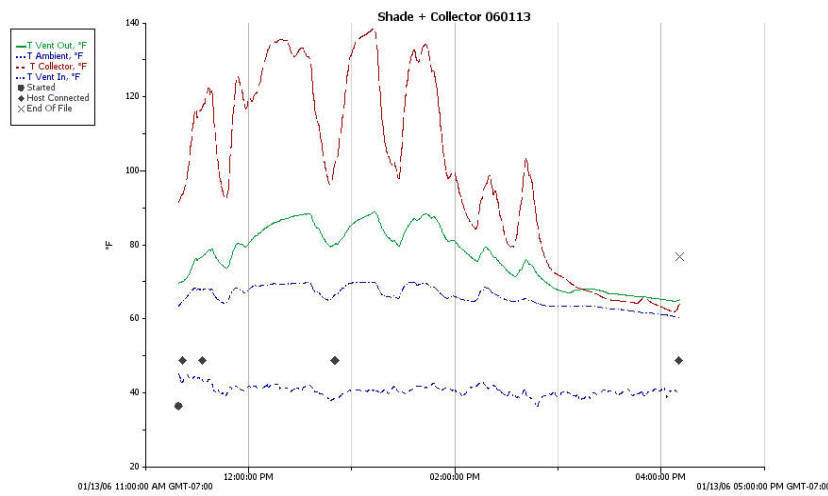
This is the sun intensity over the
same time period.
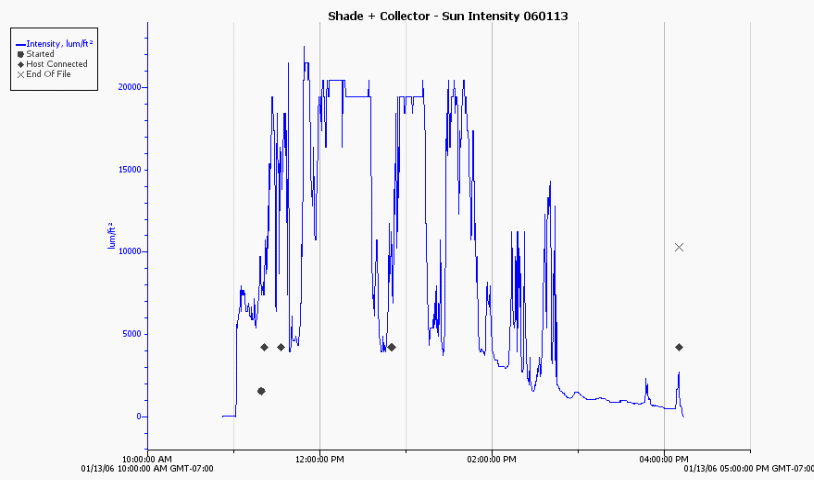
I think that with a better fit on the
edges and a darker color on the back of the shade , that the collection
efficiency could be improved by a lot.
One way to get the better edge fit
would be to use the "energy tracks" from Symphony shades.
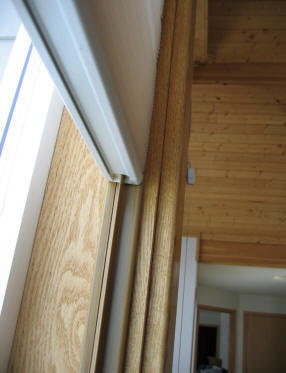
The edge track is installed on the
vertical edges of the window frame. The edge track engages a slot or
groove in the edges of the pleated shades, so that the air has a harder time
leaking between the edges of the shade and the window frame.
Better pic here:
http://symphonyshades.com/comfortracks.html
We have used these on some of our
windows for several years and like them.
1/17/06 Performance Update With
Improvements: (much better)
I had another go at measuring the
performance after making these changes:
-
To darken the absorber surface, I
taped a sheet of black "weed" cloth to the back side of the shade. Weed
cloth is a landscaping material that you put down on the ground to prevent
weeds from growing. Its about like a fine mesh shade cloth -- its black,
but you can see quite a bit of light through it.
I'm not particularly recommended weed cloth -- I just had it on hand -- I
think it smells a bit when heated.
-
Closed up the gaps along the edges
of the shade with spacers. They are still not very tight, but much
better than they were.
With the weed cloth in place, not as
much light comes through the window to light the room, but its still enough to
make the room pretty bright when sun is on the window.
The performance with the changes is
much better:
About a factor of 4 improvement!
The logger temperature and sun plots are below.
Day Output:
The output for the day was about:
Qout for day =
(106 BTU/hr-ft^2)(6 hrs/day)(18.7 ft^2) = 12,000 BTU
or, about (12000 BTU) ($2/gal)/((92000BTU/gal)(0.7 efic) )= $0.37 per day, maybe
$40 a heating season
The 106 BTU output
per hour per sqft is from the calculation just below.
Compare the Collector/Shade to a
Known Good Air Collector:
Output per square foot:
Qshade = (Tout -
Tinlet)(AventOut)(VventOut)(density)(SpecificHeat
of Air)/(Acollector)
= (37F)(0.715ft^2)(80ft/min)(60 min/hr)(0.065lb/ft^3)(0.24 BTU/lb-F) /(20.9ft^2)
= 95 BTU/hr-ft^2
Output of workshop collector under
same conditions:
Qws =
(56F)(140fpm)(0.5ft^2)(60 min/hr)(0.065 lb/ft^3) (0.24 BTU/lb-F)/(16 ft^2) = 229
BTU/hr-ft^2
So, its about half as efficient as the
my workshop collector, which I believe to be a good one -- not too bad?
This may be unfair to the window
collector, in that the shop collector has a taller (7 ft ) thermal stack driving
the flow.
Compare the Collector/Shade to a
Direct Gain Window:
How does the output of the
Collector/Shade compare to just pulling the shade up during the times when the
sun is shining and letting the sun shine into the room where it is absorbed by
room surfaces?
In rough terms: Assume that the sun power input is
250 BTU/hr-ft^2, and 80% transmittance through the glazing, and that the double
pane window glass is R2, then the net energy collected if the shade is up is:
Qwindow = (solar gain) - (window heat
loss)
Qwindow = (250 BTU/hr-ft^2)(0.8
trans) - (1 ft^2)(70F - 33F) / (R2) =
= 200 BTU/ft^2 - 54 BTU/ft^2 = 146 BTU/ft^2
So, maybe the collector/shade does
not do as good a job as just opening the shade to let the sun in. Not too
surprising. But, there are windows and times that you don't want the shade
open, and the collector shade still does a pretty good job of collecting energy
then.
All of these calculations have large
tolerances associated with them -- they are just intended to give a rough idea
what's going on, and as a guide for further changes.

Collector temperatures with
improvements -- full sun
(note that the plot title is wrong --
left over from an old plot -- the data is OK)

Sun intensities to go with temp chart
above
During times of full sun, the vent
velocity was 80 ft/min (as measured by the Kestrel wind meter and the Dwyer Vane
Velocity meter).
Potential Further Improvements:
More changes might be made to improve
the collector/shade:
-
The gaps along the edges of the
shade could be closed up tighter.
-
A shade with "Energy Tracks" could
be used to seal the edges better (see Energy Tack above)
-
The back draft damper geometry is
not ideal -- this might be improved (see below)
-
A flow divider configuration (as
proposed by Pine/Delaney) might improve performance.
-
??
The back draft dampers (in the bottom
slot) swing toward the window, and tend to obstruct part of the flow channel
between the shade and the window. This restricts the flow to some degree
and is not desirable. Maybe there is a better back draft damper
configuration?
Construction Pictures:
The construction is very easy -- took
a little over an hour.
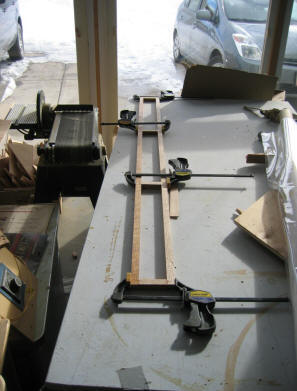
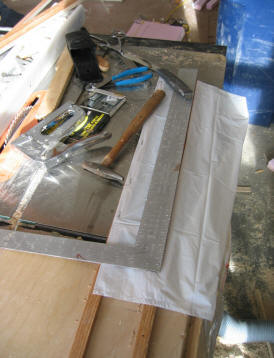
The lower spacer, and applying the
back-draft damper plastic to the spacer (Costco garbage bags).
The plastic is just stapled to the
spacer. I stapled it down first, and then trimmed it to size with a razor
knife.
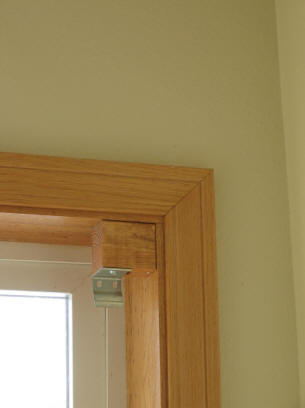
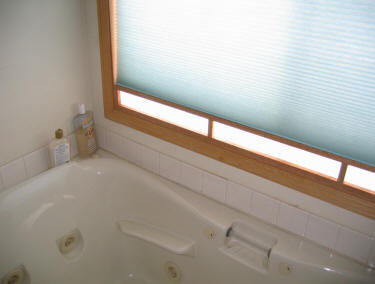
Upper spacer to create vent slot
along top of shade. Lower spacer and back-draft dampers in position.
The shade snaps into the metal clip.
Each upper spacer has a single
drywall screw into the window frame. The screw is counter sunk 3/4 of the
way into the spacer.
Instrumentation:
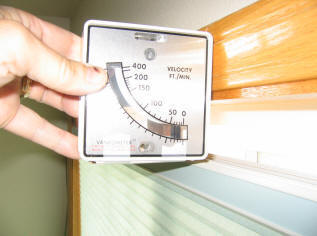
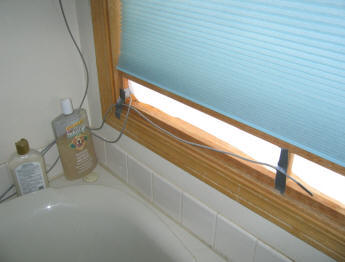
The $25 Dwyer air velocity meter.
Onset logger temperature probe.
I really like this little meter.
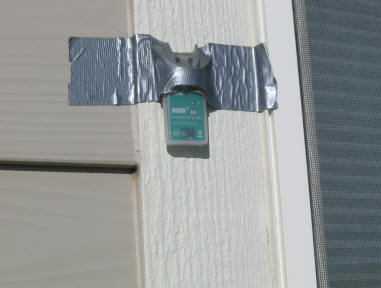
The new Onset Computer pendant sun
intensity logger.
Logs sun intensity and temperature
for days -- waterproof -- $60.
Not intended for precise
measurements, but gives a reasonable idea of sun intensity for not much money or
hassle.
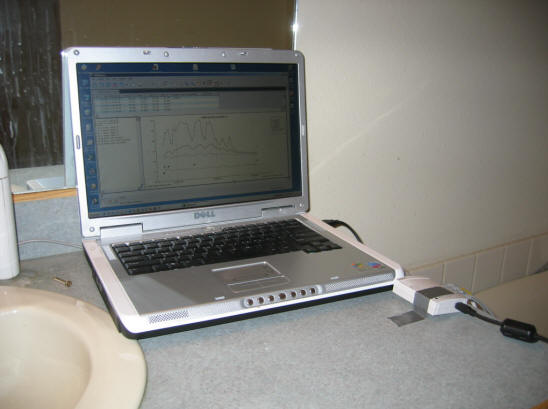
The Onset 4 channel logger (the
little white box), and readout from same.
Gary
1/13/06, 1/17/06






